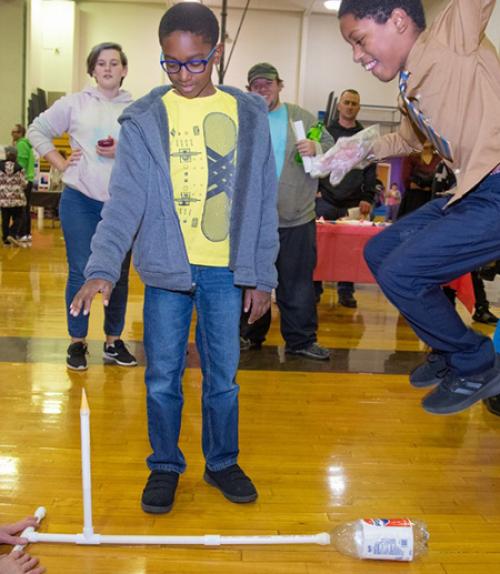The opportunity to send a science experiment into orbit drew dozens of children and their families to Space Night at Case Middle School in Watertown, New York, Nov. 9. Student teams from after-school programs in Jefferson County, many of whom worked with scientist advisers at Cornell, presented their proposals for experiments that could be delivered to the International Space Station next summer.
Three proposals were selected to go to the next level of the competition, in which the Student Spaceflight Experiments Program (SSEP) National Step 2 Review Board will select one experiment for flight.
“I was flooded with excitement,” said finalist sixth-grader Agnika Ghatak, whose team proposal examines how rust might be removed from a surface in the microgravity environment of the space station. “I tried as hard as I could not to scream out loud.”
All students in after-school programs that Cornell Cooperative Extension of Jefferson County (CCE Jefferson) administers – in 16 different schools across eight districts – had the opportunity to develop a proposal. As kids and parents blasted paper rockets into the air and tried out other hands-on activities in the bustling gymnasium, Mitch McCormick, CCE Jefferson’s 4-H after-school director, said, “The biggest challenge is that the experiment focus could be whatever kids chose it to be.”
One of those experts was Nate Rogers, a Cornell doctoral student in mechanical engineering who studies deformation mechanisms in metallic thin films. Watertown 10th-graders Mallory Loving and Illianna McCaskill were interested in studying the impact of microgravity on the corrosion and structural integrity of metals, and they consulted with Rogers via phone and email on what sorts of materials they could investigate, the appropriate sizes of samples and where to source them.
Rogers said he was pleased to offer his knowledge to help the students, and as a student whose research is funded by the National Science Foundation, he said he has a responsibility to pursue outreach and share what he knows. “We need to give back and make sure what we’re learning and doing has an impact on people outside our technical disciplines,” Rogers said.
This competition isn’t typical, said SPIF’s Zoe Learner Ponterio. “They’re learning the scientific method … by literally doing it from scratch,” said Learner Ponterio, who delivered the keynote address at Space Night, offering the budding scientists insights into careers they can follow to get involved in the space program. “It’s not the same as being in a school and being given a lab assignment, where it’s all been laid out for you,” she said. “This gives them the chance for it to be their own work, to really just start with the question and develop the whole thing.”
McCormick said CCE Jefferson provided the bulk of the funds for the students in the after-school program to participate in SSEP, which is a program of the National Center for Earth and Space Science Education (NCESSE). SSEP is enabled through a strategic partnership with DreamUp PBC and NanoRacks LLC, which are working with NASA under a Space Act Agreement as part of the utilization of the International Space Station as a national laboratory. Other funders include the New York State 4-H Foundation, Cornell’s New York State Space Grant, the Indian River Department of Defense Education Act Program and donors.
Now that the field has been narrowed to three finalists, the SSEP National Step 2 Review Board will select the top proposal in the coming weeks, said McCormick. The winning team will create the experiment inside a flight certified mini-laboratory provided by the center, and their experiment, along with 40 others, will launch aboard a SpaceX rocket in 2019.




